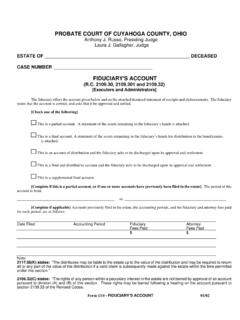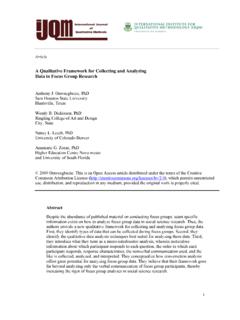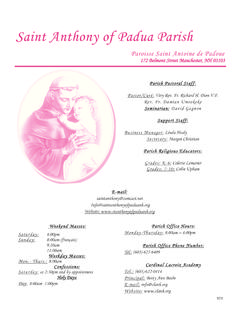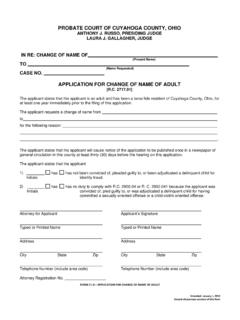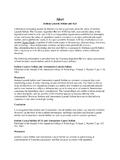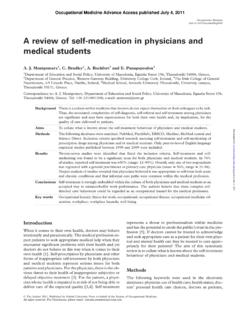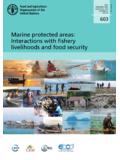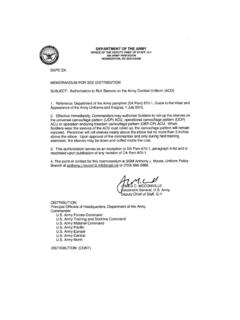Transcription of Editorial: Evidence-Based Guidelines for Avoiding the Most ...
1 Copyright 2010 by the RESEARCH IN THE SCHOOLS Mid-South Educational Research Association ix-xxxvi ix RESEARCH IN THE SCHOOLS Editorial: Evidence-Based Guidelines for Avoiding the Most Common APA Errors in Journal Article Submissions anthony J. Onwuegbuzie, Julie P. Combs, John R. Slate, and Rebecca K. Frels Sam Houston State University As co-editors and first-round copyeditors of Research in the Schools (John R. Slate and anthony J. Onwuegbuzie), outgoing editor and associate editor of Educational Researcher ( anthony J.)
2 Onwuegbuzie and Julie P. Combs, respectively), recent guest editor of the International Journal of Multiple Research Approaches ( anthony J. Onwuegbuzie), editorial assistant/production editor of Research in the Schools (Rebecca K. Frels), and reviewers for and editorial board members of numerous journals, we have observed the difficulties that many authors have experienced in conforming to the Guidelines specified in various editions of the Publication Manual of the American Psychological Association (APA) hereafter called the Publication Manual. Further, as instructors of graduate-level research methods and writing courses, as well as other courses in which one or more substantive writing assignments are required, we have seen our students struggle to an even greater extent in conforming to the Publication Manual Guidelines .
3 And, examining the rampant nature of APA errors in doctoral dissertations (see, for , Jiao, Onwuegbuzie, & Waytowich, 2008; Onwuegbuzie, Waytowich, & Jiao, 2006; Waytowich, Onwuegbuzie, & Jiao, 2006), it is clear that a substantial proportion of doctoral students from the social and behavioral science fields graduate without an adequate knowledge of the Publication Manual style. Unfortunately, this inadequacy likely makes the transition from doctoral student to beginning author to emergent scholar more difficult. Indeed, over the years, we have observed that some of our reviewers ( , editorial board members) have extremely low tolerance for APA errors.
4 Thus, it is clear that authors who submit manuscripts to journals wherein APA style is required would benefit from becoming as familiar as possible with the Publication Manual. Unfortunately, during the last 9 years, authors have had to become familiar with up to 467 pages of the fifth edition of the Publication Manual (APA, 2001), which is an extremely daunting task. Nor does the Publication Manual contain elements in sections that are presented sequentially in order of difficulty or elements in sections that build directly on each other. For example, in the fifth edition of the Publication Manual, should an author learn how to express ideas and reduce bias in language (chapter 1) before or after learning about APA editorial style (chapter 3)?
5 As another example, within APA editorial style, should an author learn about capitalization (sections ) before or after learning about numbers (sections )? Similarly, where should an instructor of the Publication Manual begin when teaching a group of students or an individual student? Without any such guidance, it is likely that students of the Publication Manual are unable to learn APA style in an optimal way, and instructors and mentors are unable to teach APA style in an efficient manner. Correspondence for this article should be addressed to anthony J. Onwuegbuzie, Department of Educational Leadership and Counseling, Box 2119, Sam Houston State University, Huntsville, Texas 77341-2119; email: In this editorial, we provide Evidence-Based Guidelines to help authors avoid committing APA errors.
6 Specifically, we provide Guidelines for adhering to APA style using findings from Combs, Onwuegbuzie, and Frels (2010) mixed analysis of 110 manuscripts submitted to Research in the Schools over a 6-year period. Combs et al. identified the 60 most common APA errors grouped into 14 themes. We contend that an efficient way for authors to learn APA style is to focus initially on these common errors and error themes. Further, we contend that these errors provide useful starting points for persons who teach APA style. Finally, authors of the APA Publication Manual might use this information to determine which rules and Guidelines to emphasize.
7 anthony J. ONWUEGBUZIE, JULIE P. COMBS, JOHN R. SLATE, AND REBECCA K. FRELS x RESEARCH IN THE SCHOOLS Since the onset of the third edition of the Publication Manual (APA, 1994), several scholars have developed tools and strategies that might assist students/authors in mastering APA writing style. In particular, Stahl (1987) documented that using checklists and aligning writing requirements across courses improved the quality of instruction in APA style. A few years later, Gelfand and Walker (1990) developed a training manual that provided students with the ability to assess their knowledge of APA Guidelines via multiple-choice items and exercises.
8 The following year, Ault (1991) designed an assignment whereby students became familiar with the appropriate structure of empirical reports by sorting scrambled paragraphs of an article into the appropriate sections. Later in that decade, Rosenthal, Soper, Coon, and Von Bergen (1999) created a procedure wherein the instructor anonymously displayed the first page of each student s manuscript via an overhead projector and co-edited each introduction section with the class. Dunn et al. (2001) developed a checklist to assist students in being aware of what they believed were some of the most common APA formatting errors.
9 During this same year, using Gelfand and Walker s (1990) training manual, Smith and Eggleston (2001) conducted a study in which 18 students read a poorly written paper and identified as many style errors as possible. Smith and Eggleston observed that students reported positive attitudes toward this assignment. Additionally, these students knowledge of APA (1994) style improved substantially as a result of the activity. Further, performance on the activity was statistically significantly and moderately ( 2 = ) related to the application of APA (1994) style in an empirical report. Ware, Badura, and Davis (2002) and Gelfand, Walker, and APA (2002) developed a set of procedures and a training manual, respectively, for learning the APA (2001) style guide.
10 Most notably, Juve, Weiser, Kennedy, Davis, and Rewey (2000) conducted a study wherein they identified the most common APA (1994) formatting errors in 69 manuscripts that were submitted to the Psi Chi Journal of Undergraduate Research. Juve et al. identified 780 total APA errors, yielding an average of formatting errors per manuscript. based on these errors, Rewey, Juve, Weiser, and Davis (2000) developed a checklist of common formatting errors. Although these manuals, techniques, guides, checklists, and assignments are useful for both students and instructors of the Publication Manual, with the exception of Juve et al.
